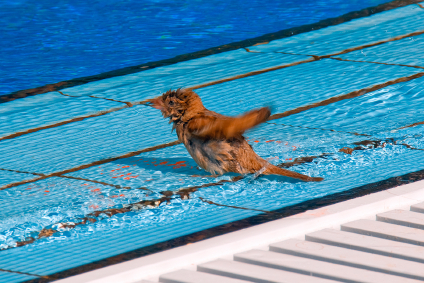
by Alex A. Kecskes
If you have pest birds hanging around your pool, you know the problems they cause. They leave droppings everywhere, which means frequent (and expensive) pool cleanings and constant hosing down of walkways, railings and steps. If you live in Southern California, ducks can be a big problem around pools. So can pigeons and grackles.
Sometimes birds clean out their nests and drop their waste in and around a pool. They often do this to avoid drawing predators to their nests. Black birds will sometimes spit in a pool. Some homeowners have resorted to poisons and BB guns. Not a good idea if you have pets or kids around (it’s also illegal to kill or harm certain birds). Others have taken to placing rubber snakes around the pool. These can be initially traumatizing to small children, and some pets have a tendency to chew and eat them. There are effective bird control devices you can use that will keep pest birds away from your pool without risking danger to people, kids, birds or pets. They include:
Bird Sonics. Mounted under eaves, patio covers or gazebos, these
bird repellent devices can keep pest birds away from your pool or spa. Bird sonics emit predator and distress calls that birds instinctively fee from. They work on a bird's natural fear of predators, as well as their acutely sensitive hearing (birds can process sounds in 1/200th of a second; humans process sounds in 1/20th of a second).
Sonic bird deterrents work well against pigeons, crows, starlings, swallows, gulls, woodpeckers, sparrows, grackles, cormorants and many other species. One commercially available sonic system blasts the sound of Peregrine falcons (a pigeon's dreaded enemy) defending their territory. Another system targets starlings and seagulls, emitting the sounds of predator hawk screeching and gulls under attack. The best sonic systems will regularly alter the pitch, frequency, timing and intensity of their sounds. This keeps pest birds from getting used to repetitive sounds. One popular system can emit distress and predator calls for as many as 22 types of birds. The calls are repeated once every fifteen minutes. Sonic bird deterrents are not harmful to birds, pets or humans. The sounds they emit merely resemble normal bird sounds.
Visual Scare Deterrents. These include Bird Scare Balloons, flash tape and twine. The balloons feature large predator eyes that make birds really nervous.
Scare Bird Diverters use the same principle. They feature a giant predator eye and can be hung under eaves to frighten birds. To keep birds, geese and ducks away from pools, fill bird scare balloons one-fourth full of water, and the rest with air. The balloons will float around the pool with predator eyes and shiny reflective surfaces constantly in motion to keep birds away.
When using visual scare devices, it’s important to move them around occasionally to prevent swallows from getting used to them.
Scarecrows. Any pest birds that approach this device’s radius of protection get hit with a stunning but harmless blast of water. The sudden water blast, alarming sprinkler sound and realistic looking bird-like moving head "persuade" birds to stay away. Scarecrows are simple to set up and easy to use. They connect to almost any garden hose, yet they consume just 2 to 3 cups of water per spray. Scarecrows cover approximately 1,200 square feet with a stream that reaches out 35 feet and 45 feet wide. They work day and night for up to 6 months and deliver over 1,000 "firings" on a single 9-volt battery. For added versatility, scarecrows can be easily fine tuned to adjust both their sensitivity and coverage distance. Incidentally, kids and dogs love to play with these devices.
Mini Scarecrow. For smaller applications, say to
keep pest birds away from walkways, pool steps, diving boards or railings, there's the Mini Scarecrow. It uses compressed air and sound to scatter pest birds and "convince" them to avoid the area. Like its big brother, the Mini comes to life the second a pest bird gets within 3 to 4 feet of its sensor. Unlike its larger brother, the Mini hits birds with a squeal and a harmless blast of air. You can easily adjust Mini's angle of detection and spray angle to zero in on trouble spots. Each can holds over 200 sprays.

